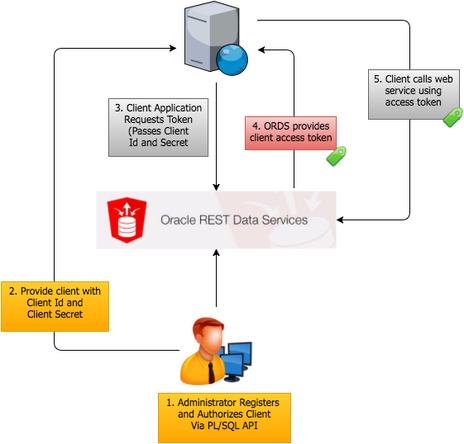Luckily for us, Oracle REST Data Services offers two approaches for securing our services using an industry standard web service authentication protocol called OAuth2.
ORDS provides two options for securing your REST web services using OAuth2:
- 'Two-legged' OAuth involves two parties, the party calling the RESTful API (the third party application), and the party providing the RESTful API. Two legged flows are typically used in server to server interactions where the calling server can securely store the credentials required to access the service. In OAuth 2.0 this flow is called the client credentials flow. It is most typically used in business to business scenarios.
- 'Three-legged' OAuth involves three parties, the party calling the RESTful API, the party providing the RESTful API, and an end-user party, who owns/manages the data that the RESTful API provides access to. Three legged flows are used in client to server interactions where an end-user must approve access to the RESTful API. In OAuth 2.0 the authorization code flow and the implicit flow are three legged flows. These flows are typically used in business to consumer scenarios.
- You develop a REST service in ORDS and secure it. You then register a 'client' application with ORDS.
- You provide the client application (usually to the administrator) the client id and client secret generated from the client registration. The client application stores the client id and client secret securely on their server.
- The client application makes a call to a special ORDS URL passing their client id and client secret.
- ORDS responds with an authorization token. By default, the token will remain active for 3,600 seconds (1 Hour).
- Once the token is obtained, the client calls the appropriate service, passing the token to gain access to the service.
Securing Your REST Service
The below example assumes you have done the following:
- Enabled ORDS in schema 'REST' using ORDS.ENABLE_SCHEMA.
- Created a module called 'v1' using ORDS.DEFINE_MODULE.
- Created a template with a pattern of 'customer' using ORDS.DEFINE_TEMPLATE.
- Created a GET handler that contains your PL/SQL logic using ORDS.DEFINE_HANDLER.
- At this point, in an unsecured state you could call this service using:
- https://example.com/ords/rest/v1/customer
- p_priviledge_name
- The name you want to give the privilege.
- p_pattern
- Is the service you want to secure. In the above example /v1/ is the module URI, and /customer is the service name.
- Note: You can use wild cards here, so you could assign all services in a module to a privilege by using ‘/v1/*’.
Creating A New Client and Associate Privilege(s)
Where:
- p_name
- Name of the client application.
- p_grant_type
- Will always be ‘client_credentials’. This is the 2-legged OAuth approach.
- p_priviledge_names
- Comma delimited list of privilege names.
Obtaining An Authorization Token
- https://example.com/ords/rest/oauth2/token
Extending the Token
Changing the default Expiration
See my post ords-changing-the-default-oauth2-token-expiry-lifetime.html for details on how to change the default expiration.



 RSS Feed
RSS Feed